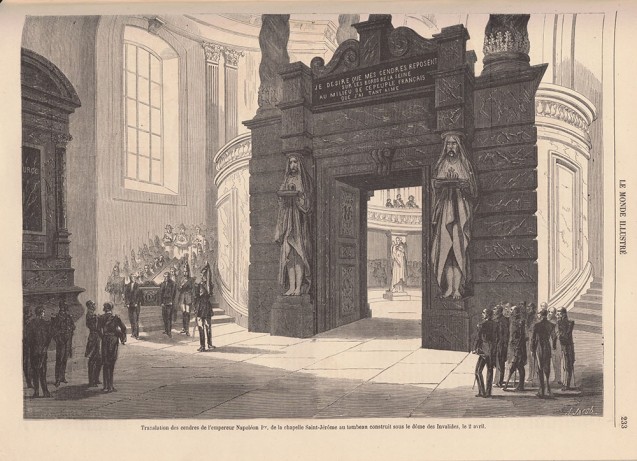When in 1840 the mortal remains of Emperor Napoleon I were brought back from St Helena, the coffin was temporarily placed in the chapel of St Jérôme at Les Invalides, until a monument worthy of the greatest genius of modern times could be erected beneath the Dome of Les Invalides, which, by its location, was the place that the illustrious deceased had himself chosen for his final resting place: “on the banks of the Seine, in the midst of the French people [he] had loved so much”. An architectural competition was advertised, and the greatest architects and sculptors took part. M. Visconti was chosen to put his name to this construction, and Pradier was called upon to decorate with monumental figures the crypt that featured in Visconti’s project.
At one point, there was talk of leaving the sarcophagus under the Dome empty and burying the Emperor’s mortal remains in the basilica of Saint Denis.
The Ceremony of which the Monde illustré today provides a drawing proves categorically that this idea has been abandoned. His Majesty the Emperor Napoleon III wanted this ceremony to have a personal feel. Her Majesty the Empress, the Prince Imperial, the princes of the family, ministers, the great officers of the crown and a few high dignitaries of the Empire were the only ones invited to the final burial. After a low mass celebrated by His Eminence the Cardinal Archbishop, the Cent Gardes, assisted by special men, took the coffin from the chapel of Saint-Jérôme and transported it below ground to the crypt where the sarcophagus was erected. The three Marshals who were in Paris at the time, Marshal Randon, Marshal Magnan and Marshal Vaillant, followed immediately behind, carrying on cushions the honours, namely, the sword, the [necklace of the Légion d’Honneur] and the hat.
The Emperor and the imperial family attended the ceremony, kneeling on the rostrum on the balcony of the crypt. The coffin was placed on a sloping platform which, starting from the entrance of the crypt itself was inclined up to the opening of the sarcophagus. No detail of this operation escaped Their Majesties, who did not withdraw until the slab which was to cover the remains of the emperor had been placed on the rollers.
A commemorative medal was placed in the sarcophagus, bearing the date of the exhumation.
On the occasion of this ceremony, His Majesty promoted General d’Ornano, Governor of Les Invalides, to the rank of Marshal of France. General Count d’Ornano had been a divisional general since 1812. M. Marchand, executor of Emperor Napoleon I’s will, was made an “Officier de la Legion d’Honneur”.
It is regrettable that the passage of time has prevented the distribution of Légion d’honneur medals to the oldest veterans of the army of the Empire. The youngest one of those who should have received from the hand of the Emperor himself this honour for which he had waited so long, had completed sixty years of service. Most of them had been nominated before 1815, and the return of the Bourbons had deprived them of their medals of Chevallier de la Légion d’Honneur. It was high time for justice to be done, because soon, perhaps, the “Egyptians” (a name given at the Hôtel des Invalides to those who took part in that great campaign for which Bonaparte was commander in chief) will no longer exist except as legends.


